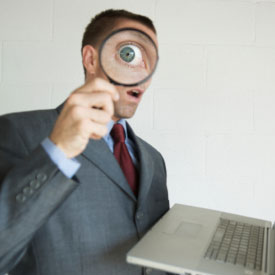How to analyze employee performance without creeping people out
In 1888, jeweller Willard Le Grand Bundy filed a patent for “The Workman’s Time Recorder,” the world’s first workplace time clock. That means bosses have been using technology to keep track of their employees for at least the last 128 years. Yet every time the tools evolve, they still cause anger.
Witness the kerfuffle at the Daily Telegraph in early January. Returning to work on a Monday morning, journalists found wireless motion sensors installed under their desks without explanation. Called the “OccupEye,” the devices theoretically allow supervisors to tell when a desk is occupied. The National Union of Journalists vowed to fight “Big Brother–style surveillance in the newsroom.”
Management quickly had the devices removed, while offering a benign—if muddled—explanation, saying in a memo to staff that the monitoring was part of an effort to make their offices as energy-efficient as possible. The sin wasn’t installing the sensors. It was failing to communicate with staff before launching the little experiment.
Two big tech trends—big data and wearables—have converged in the office cubicle. Companies like OccupEye or Massachusetts-based Humanyze allow employers to monitor office activity in minute detail. (Humanyze makes an ID lanyard that tracks not only location in the office, but frequency of speech, tone of voice and body language, too.)
What sounds intrusive can become a welcome benefit for employees—if it’s handled correctly. The founders of Klick Health, a Toronto-based digital marketing agency, take a data-driven approach to management, using everything from card swipes to project management software to track employee performance. Yet they’ve done it in a way that makes employees feel supported rather than surveilled. Their staff attrition rate is roughly 3%, exponentially lower than their industry’s standard. In the 2014 book The Decoded Company, Klick CEO Leerom Segal and three co-workers articulate some clear principles underlying their approach. Perhaps most important: If the data isn’t something that employees assume is part of their record, like the number of vacation days taken or billable hours, then they should opt-in to having it collected.
Further, there’s an onus on employers to demonstrate how the data collection is worthwhile for everyone. “Data can be used constructively or destructively,” the authors write. Analyzing door swipe-access data can be used by a manager to dish out reprimands for lateness; it can also help spot burnt-out employees who need a day off.
There are myriad examples of data-collection done right. Humanyze discovered Bank of America call-centre employees were more effective when they talked to their co-workers more often, so entire teams started taking lunch breaks at the same time. Productivity soon increased by 20% while reported stress levels dropped by 19%. Meanwhile, employee at Deloitte’s Halifax office who experimented with the technology found having access to their own data helped with career development. “The minute that you get the report that you’re not speaking enough and that you don’t show leadership, immediately, the next day, you change your behaviour,” one told the CBC.
The collection of workplace data needn’t translate into an Orwellian future. In many places it’s already had a positive effect. But it’s up to Big Brother to prove he’s worth trusting.
Source: Canadian Business


